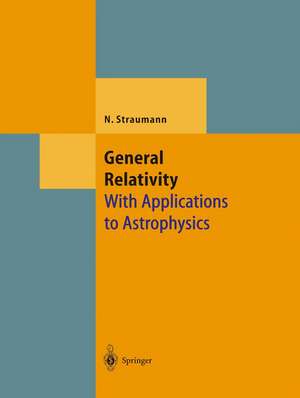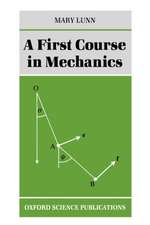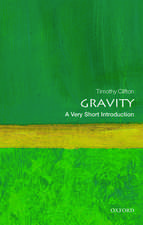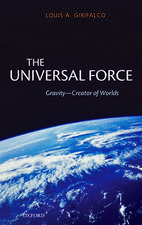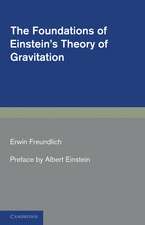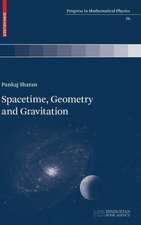General Relativity: With Applications to Astrophysics: Theoretical and Mathematical Physics
Autor Norbert Straumannen Limba Engleză Paperback – dec 2010
| Toate formatele și edițiile | Preț | Express |
|---|---|---|
| Paperback (2) | 514.13 lei 43-57 zile | |
| SPRINGER NETHERLANDS – 9 noi 2014 | 514.13 lei 43-57 zile | |
| Springer Berlin, Heidelberg – dec 2010 | 654.12 lei 43-57 zile | |
| Hardback (1) | 667.86 lei 43-57 zile | |
| SPRINGER NETHERLANDS – 9 oct 2012 | 667.86 lei 43-57 zile |
Din seria Theoretical and Mathematical Physics
- 20%
 Preț: 697.22 lei
Preț: 697.22 lei - 18%
 Preț: 744.84 lei
Preț: 744.84 lei - 20%
 Preț: 699.49 lei
Preț: 699.49 lei -
 Preț: 396.81 lei
Preț: 396.81 lei - 15%
 Preț: 721.06 lei
Preț: 721.06 lei - 18%
 Preț: 1120.68 lei
Preț: 1120.68 lei -
 Preț: 398.35 lei
Preț: 398.35 lei - 15%
 Preț: 643.65 lei
Preț: 643.65 lei - 15%
 Preț: 508.60 lei
Preț: 508.60 lei - 20%
 Preț: 652.54 lei
Preț: 652.54 lei - 15%
 Preț: 646.75 lei
Preț: 646.75 lei - 15%
 Preț: 649.87 lei
Preț: 649.87 lei -
 Preț: 396.24 lei
Preț: 396.24 lei - 15%
 Preț: 653.14 lei
Preț: 653.14 lei - 18%
 Preț: 960.78 lei
Preț: 960.78 lei - 15%
 Preț: 529.92 lei
Preț: 529.92 lei - 18%
 Preț: 1127.78 lei
Preț: 1127.78 lei - 18%
 Preț: 1554.09 lei
Preț: 1554.09 lei - 15%
 Preț: 551.53 lei
Preț: 551.53 lei - 18%
 Preț: 1002.75 lei
Preț: 1002.75 lei -
 Preț: 396.02 lei
Preț: 396.02 lei - 15%
 Preț: 648.89 lei
Preț: 648.89 lei - 18%
 Preț: 783.35 lei
Preț: 783.35 lei - 18%
 Preț: 973.38 lei
Preț: 973.38 lei - 18%
 Preț: 907.90 lei
Preț: 907.90 lei - 15%
 Preț: 655.78 lei
Preț: 655.78 lei - 18%
 Preț: 1118.93 lei
Preț: 1118.93 lei -
 Preț: 390.25 lei
Preț: 390.25 lei - 15%
 Preț: 663.79 lei
Preț: 663.79 lei - 15%
 Preț: 653.79 lei
Preț: 653.79 lei - 15%
 Preț: 645.28 lei
Preț: 645.28 lei - 15%
 Preț: 604.23 lei
Preț: 604.23 lei - 15%
 Preț: 639.25 lei
Preț: 639.25 lei - 15%
 Preț: 590.81 lei
Preț: 590.81 lei -
 Preț: 395.25 lei
Preț: 395.25 lei - 15%
 Preț: 589.33 lei
Preț: 589.33 lei - 19%
 Preț: 543.18 lei
Preț: 543.18 lei - 15%
 Preț: 594.24 lei
Preț: 594.24 lei - 18%
 Preț: 916.57 lei
Preț: 916.57 lei - 18%
 Preț: 957.75 lei
Preț: 957.75 lei -
 Preț: 409.13 lei
Preț: 409.13 lei - 15%
 Preț: 532.23 lei
Preț: 532.23 lei
Preț: 654.12 lei
Preț vechi: 769.56 lei
-15% Nou
Puncte Express: 981
Preț estimativ în valută:
125.17€ • 131.01$ • 104.18£
125.17€ • 131.01$ • 104.18£
Carte tipărită la comandă
Livrare economică 31 martie-14 aprilie
Preluare comenzi: 021 569.72.76
Specificații
ISBN-13: 9783642060137
ISBN-10: 3642060137
Pagini: 692
Ilustrații: XII, 676 p.
Dimensiuni: 210 x 279 x 35 mm
Greutate: 0.95 kg
Ediția:Softcover reprint of hardcover 1st ed. 2004
Editura: Springer Berlin, Heidelberg
Colecția Springer
Seria Theoretical and Mathematical Physics
Locul publicării:Berlin, Heidelberg, Germany
ISBN-10: 3642060137
Pagini: 692
Ilustrații: XII, 676 p.
Dimensiuni: 210 x 279 x 35 mm
Greutate: 0.95 kg
Ediția:Softcover reprint of hardcover 1st ed. 2004
Editura: Springer Berlin, Heidelberg
Colecția Springer
Seria Theoretical and Mathematical Physics
Locul publicării:Berlin, Heidelberg, Germany
Public țintă
GraduateCuprins
1 Physics in External Gravitational Fields.- 2 Einstein’s Field Equations.- 3 The Schwarzschild Solution and Classical Tests of General Relativity.- 4 Weak Gravitational Fields.- 5 The Post-Newtonian Approximation.- 6 White Dwarfs and Neutron Stars.- 7 Black Holes.- 8 The Positive Mass Theorem.- 9 Differentiable Manifolds.- 10 Tangent Vectors, Vector and Tensor Fields.- 11 The Lie Derivative.- 12 Differential Forms.- 13 Affine Connections.- 14 Some Details.- A Fundamental Equations for Hypersurfaces.- B Ricci Curvature of Warped Products.- C Frobenius Integrability Theorem.- D Collection of Important Formulas.- References.
Recenzii
From the reviews:
"In this book Norbert Straumann presents a pedagogically precise and highly informative account of both the physical and advanced mathematical concepts that a professional working in this field requires. The essential differential geometry background is placed in an extensive part … . the treatment is both physically rigorous and comprehensive. This book is an important acquisition for anyone working in this area." (Geoffrey Bicknell, Australian Physics, Vol. 42 (4), September/October, 2005)
"This text provides a comprehensive and timely introduction to general relativity. … The book addresses undergraduate and graduate students in physics, astrophysics and mathematics. It is very well structured and should become a standard text for a modern treatment of gravitational physics. The clear presentation of differential geometry makes it also useful for strong theory and other fields of physics, classical as well as quantum." (ETDE Energy Database Energiedatenbank, November, 2004)
"From the earliest sections, Straumann makes absolutely no pretence that this is a beginner’s guide to general relativity … . There are points of interest for those disinclined (or unable) to follow the maths in detail. … this book is primarily aimed at those who want to get very, very intimate with the mathematics of general relativity in an astrophysical …. context and who are endowed with a considerable background in all three subjects. … this may be the ultimate specialist textbook." (Roger Feasey, Journal of the Auckland Astronomical Society, 2005)
"In this book Norbert Straumann presents a pedagogically precise and highly informative account of both the physical and advanced mathematical concepts that a professional working in this field requires. The essential differential geometry background is placed in an extensive part … . the treatment is both physically rigorous and comprehensive. This book is an important acquisition for anyone working in this area." (Geoffrey Bicknell, Australian Physics, Vol. 42 (4), September/October, 2005)
"This text provides a comprehensive and timely introduction to general relativity. … The book addresses undergraduate and graduate students in physics, astrophysics and mathematics. It is very well structured and should become a standard text for a modern treatment of gravitational physics. The clear presentation of differential geometry makes it also useful for strong theory and other fields of physics, classical as well as quantum." (ETDE Energy Database Energiedatenbank, November, 2004)
"From the earliest sections, Straumann makes absolutely no pretence that this is a beginner’s guide to general relativity … . There are points of interest for those disinclined (or unable) to follow the maths in detail. … this book is primarily aimed at those who want to get very, very intimate with the mathematics of general relativity in an astrophysical …. context and who are endowed with a considerable background in all three subjects. … this may be the ultimate specialist textbook." (Roger Feasey, Journal of the Auckland Astronomical Society, 2005)
Textul de pe ultima copertă
This text provides a comprehensive and timely introduction to general relativity. The foundations of the theory in Part I are thoroughly developed together with the required mathematical background from differential geometry in Part III. The six chapters in Part II are devoted to tests of general relativity and to many of its applications. Binary pulsars are studied in considerable detail. Much space is devoted to the study of compact objects, especially to black holes. This includes a detailed derivation of the Kerr solution, Israel's proof of his uniqueness theorem, and derivations of the basic laws of black hole physics. The final chapter of this part contains Witten's proof of the positive energy theorem.
The book addresses undergraduate and graduate students in physics, astrophysics and mathematics. It is very well structured and should become a standard text for a modern treatment of gravitational physics. The clear presentation of differential geometry makes it also useful for string theory and other fields of physics, classical as well as quantum.
The book addresses undergraduate and graduate students in physics, astrophysics and mathematics. It is very well structured and should become a standard text for a modern treatment of gravitational physics. The clear presentation of differential geometry makes it also useful for string theory and other fields of physics, classical as well as quantum.
Caracteristici
This book provides all the necessary mathematics and also the foundations of Einstein's theory; this makes it quite different from other monographs on Relativistic Astrophysics Includes supplementary material: sn.pub/extras
Notă biografică
Norbert Straumann (born 6 August 1936 in Niedererlinsbach) is a Swiss physicist. He attended public schools and studied physics and mathematics at the ETH in Zurich, where his instructors included Heinz Hopf, Res Jost, Wolfgang Pauli, Paul Scherrer, Eduard Stiefel, Walter Heitler, Rolf Nevanlinna and Bartel Leendert van der Waerden.
In his diploma thesis in 1959, Professor Straumann dealt with the characterization of generalized free fields in the axiomatic field theory, which he wrote under the direction of Res Jost. In 1961 he completed his doctorate under Walter Heitler with a thesis on hyperon and meson mass differences in a non-local field theory. In subsequent years, he was a research associate of Walter Heitler.
From 1964 to 1965 he was a Fellow at CERN in Geneva, serving as an assistant professor at the University of Zurich. From 1967 to 1968 he taught as an associate professor at Duke University in North Carolina. At that time his focus was on the mass differences for bosons and the current algebra, a forerunner of the modern theory of strong interactions.
In 1969 he began forming a theory group for the former Swiss Institute for Nuclear Research (now the Paul Scherrer Institute). In the seventies he changed his focus, growing more interested in the theory of gravitation. In this context, he placed great emphasis on the historical aspects of gravity.
In 1969, Straumann became a professor at the University of Zurich, and the years and decades that followed saw him increasingly involved in major associations. From 1980-1987 he was a member of the Scientific Council at the Swiss National Science Foundation; from 1985-1986 he was a visiting professor at the Institute for Theoretical Physics at the University of Bern. In 1988 he was a visiting professor in Amsterdam. From 1997-2000 he worked on an advisory board of the Albert Einstein Institute in Potsdam.
In 2001 he retired, and has since written a number offurther works on the theory of gravitation, primarily addressing the classic fields of theoretical physics (mechanics, electrodynamics, thermodynamics and kinetic theory, statistical mechanics, special relativity, general relativity and astrophysics, cosmology and black holes). His lecture notes, which have partly been published in book form, influenced a whole generation of students and researchers at the University of Zurich.
In recognition of his achievements, in 2005 Norbert Straumann was awarded the title of Doctor Philosophiae Honoris Causa from the University of Bern.
In his diploma thesis in 1959, Professor Straumann dealt with the characterization of generalized free fields in the axiomatic field theory, which he wrote under the direction of Res Jost. In 1961 he completed his doctorate under Walter Heitler with a thesis on hyperon and meson mass differences in a non-local field theory. In subsequent years, he was a research associate of Walter Heitler.
From 1964 to 1965 he was a Fellow at CERN in Geneva, serving as an assistant professor at the University of Zurich. From 1967 to 1968 he taught as an associate professor at Duke University in North Carolina. At that time his focus was on the mass differences for bosons and the current algebra, a forerunner of the modern theory of strong interactions.
In 1969 he began forming a theory group for the former Swiss Institute for Nuclear Research (now the Paul Scherrer Institute). In the seventies he changed his focus, growing more interested in the theory of gravitation. In this context, he placed great emphasis on the historical aspects of gravity.
In 1969, Straumann became a professor at the University of Zurich, and the years and decades that followed saw him increasingly involved in major associations. From 1980-1987 he was a member of the Scientific Council at the Swiss National Science Foundation; from 1985-1986 he was a visiting professor at the Institute for Theoretical Physics at the University of Bern. In 1988 he was a visiting professor in Amsterdam. From 1997-2000 he worked on an advisory board of the Albert Einstein Institute in Potsdam.
In 2001 he retired, and has since written a number offurther works on the theory of gravitation, primarily addressing the classic fields of theoretical physics (mechanics, electrodynamics, thermodynamics and kinetic theory, statistical mechanics, special relativity, general relativity and astrophysics, cosmology and black holes). His lecture notes, which have partly been published in book form, influenced a whole generation of students and researchers at the University of Zurich.
In recognition of his achievements, in 2005 Norbert Straumann was awarded the title of Doctor Philosophiae Honoris Causa from the University of Bern.
